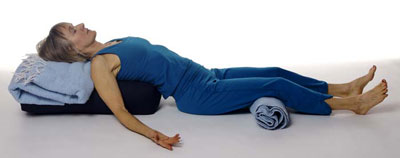(Notes from the Detroit workshop, January 2013)
I love trinities. I see them everywhere and love when new ones pop up. Our weekend focus is on one that has just come to me, although it is not totally new: mobility, motility and stillness. This trinity offers us a key to unlocking the secret of yoga. Finding balance and harmony in the first two creates a possible opening into the third, the unbounded infinite open heart. Just as the eternal ‘Now’ is not the absence of time, stillness, as I am using the word here, is not the absence of movement, but the ever-present source of all movement. Patanjali calls this purusha.
We can also another connection that might be helpful. Mobility involves the gross or physical body, the body of weight and mass. Motility is the subtle or energy body with no mass but measurable movement. The causal or ‘bliss’ body (anandamaya kosha) refers to the fields such as gravity and electromagnetism that shape the movements of matter and energy. “Stillness’, as we are using the term is actually the source of all ‘three bodies’ and thus accessible from anywhere at any time. However, the stability of the causal body allows it to be the most likely place from which we can ‘let go’ into the stillness.
Mobility
For those of us who practice and teach a somatic based enquiry, we usually begin with the most tangible, the most accessible: the gross body or body of weight and mass (sthula sharira in Sanskrit). Mobility is the ability of this body to move through space. Animals are mobile. Plants, for the most part are not. Animals have nervous systems which have evolved to organize movements in space. Plants do not have nervous systems. (See the ” i of the Vortex” by Rodolfo Llinas for a brilliant exposition of the evolution of the nervous system.) Animals have muscles and bones and it is through these that most humans discover movement. In a hatha yoga practice, our first goal is usually to optimize the capacity of the body to move. Here, the most simple movements are returned to their naturally elegant, graceful and effortless level of expression.
To keep life simple, we will explore the three fundamental movements of the pelvis in relation to the legs and how the legs and feet provide a stable base for these movements. These are the foundation to the beginning level poses. We will look at sustaining, or staying in a pose for many breaths in the motility section. (There are also situations where restorative poses are necessary at the beginning, with no outer movements, and we will visit that in motility.) Here is a away to introduce elegant mobility to new students.
Tadasana; here we stabilize the feet, and mobilize the ankles, knees and hips. Imagine you are on skis (or ice skates, surfboard, skateboard etc) where your feet play a crucial role in feeling the earth beneath you and your legs are dynamically interacting with gravity. There is a flow of energy linking the joints and muscles as they continuously adapt to the changing terrain. As you stand with feet hip width apart, find this state of being both relaxed and alert and feel it throughout the body. As you stand on your mat, let your ankles, hips and knees move as your feet stay still. Let the whole body feel supported.
When the legs are awake we can add the three basic movements of the pelvis turning around the hip joints, forward flexion/extension (forward and backbending postures), lateral flexion and extension (of the pelvis!) like trikonasana and its cousins, and rotation or twisting. In teaching all levels of yoga students, these three movements are foundational. To begin this pelvic exploration we will add a bonus to the body. Our human tail is very limiting so we will grow a new one, with our imagination and energy.
So, grow yourself a tail. Let your imagination expand. Cats, birds, fish, lizzards, or even a kangaroo are possible options. Feel the energy of the tail extending down and back to offer more support and relief to the spinal muscles. This vector (direction of flow) takes you away from your head. Let it extend even beyond your imaginary tail so it continues on into space.
From tadasana we will now explore forward bending or forward flexion and its complement, extension. Let your tail go back and up to help bring your torso forward and down. Feel the pelvis and hips at the very center of the movement, the femur bones being the fulcrum of the see-saw, so you feel perfectly balanced all the way down. Pause, and then using your tail, return to the upright position. Repeat the cycle again and again, as slowly as possible.
The secret to healthy expressions of mobility is the ability to first feel a pair of even, balanced, complementary movements around a still point, which here are the femur heads.  Let the body relax in skier’s tadasana and feel the changes as you move in and out of the forward bend. Take your feet wider apart and explore the same movements. Prasarita padottanasana is the Sanskrit name for the wide leg pose . If you have the flexibility, let your head and or elbows come to the floor as well, but the movements in and out are what is important.
Let the body relax in skier’s tadasana and feel the changes as you move in and out of the forward bend. Take your feet wider apart and explore the same movements. Prasarita padottanasana is the Sanskrit name for the wide leg pose . If you have the flexibility, let your head and or elbows come to the floor as well, but the movements in and out are what is important. 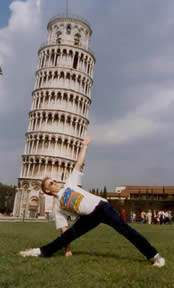 Experience many different distances between the feet, not just two. Each will offer new sensations and the possibility of greater ease.
Experience many different distances between the feet, not just two. Each will offer new sensations and the possibility of greater ease.
Next comes the lateral or fish body poses, of which triangle pose is the all time greatest. It is in my top three of all time favorite asanas. Imagine a tail, like a fish, extending away from the human tail. Visualize a circle, or even better, concentric circles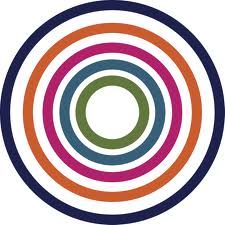 , and move in and out of the pose riding on the circles like a half-pipe in skiing. Smooth out the movements and the energy flow. Try the same in parsvakonasana and ardha chandrasana. Remember to do both sides equally. We are not staying in the postures yet. That will come in the motility section. Try to find a clear clean circle of energy in the side plane. This is where trikonasana shines!
, and move in and out of the pose riding on the circles like a half-pipe in skiing. Smooth out the movements and the energy flow. Try the same in parsvakonasana and ardha chandrasana. Remember to do both sides equally. We are not staying in the postures yet. That will come in the motility section. Try to find a clear clean circle of energy in the side plane. This is where trikonasana shines!
Finally we rotate. Because the legs can inhibit pelvic rotation, the bet way to develop mobility here is to use ardha chandrasa as a starting point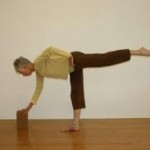 , using blocks if necessary, keep the standing leg till and rotate the pelvis around to parvrtta ardha chandrasana
, using blocks if necessary, keep the standing leg till and rotate the pelvis around to parvrtta ardha chandrasana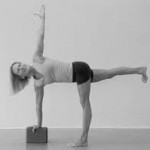 . Again, we are not yet staying in the pose, but exploring and liberating the mobility in the body so repeat back and forth as slowly and smoothly as possible. (Great thanks to Onecenteryoga in Asheville, NC for the photos).
. Again, we are not yet staying in the pose, but exploring and liberating the mobility in the body so repeat back and forth as slowly and smoothly as possible. (Great thanks to Onecenteryoga in Asheville, NC for the photos).
The standing poses offer the best leverage for opening the hip joint mobility.  We are not necessarily trying to greatly increase range of motion as we are are looking to create balanced, elegant centered movements around a stable base. Ardha chandrasana can be an entry into one legged dog pose where we use the hip mobility of help lengthen the spine and open the shoulders. From here,
We are not necessarily trying to greatly increase range of motion as we are are looking to create balanced, elegant centered movements around a stable base. Ardha chandrasana can be an entry into one legged dog pose where we use the hip mobility of help lengthen the spine and open the shoulders. From here, 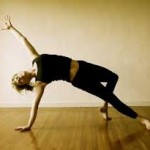 ‘flipping’ the dog uses the pelvis mobility and also takes you deeper into the organic movements we will discuss in motility, (coming in part 2). Practice moving in and out as slowly as possible to increase sensitivity and elegance.
‘flipping’ the dog uses the pelvis mobility and also takes you deeper into the organic movements we will discuss in motility, (coming in part 2). Practice moving in and out as slowly as possible to increase sensitivity and elegance.
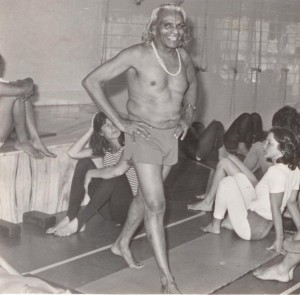 w Stuff Works” series, the study of the physiology of laughter. His article on “How Laughter Works ” (http://science.howstuffworks.com/life/laughter1.htm) has lots of fun information on this delightful physiological phenomenon. “Laughter is the physiological response to humor. Laughter consists of two parts — a set of gestures and the production of a sound. When we laugh, the brain pressures us to conduct both those activities simultaneously. When we laugh heartily, changes occur in many parts of the body, even the arm, leg and trunk muscles.” and …
w Stuff Works” series, the study of the physiology of laughter. His article on “How Laughter Works ” (http://science.howstuffworks.com/life/laughter1.htm) has lots of fun information on this delightful physiological phenomenon. “Laughter is the physiological response to humor. Laughter consists of two parts — a set of gestures and the production of a sound. When we laugh, the brain pressures us to conduct both those activities simultaneously. When we laugh heartily, changes occur in many parts of the body, even the arm, leg and trunk muscles.” and …

